If you love a meltingly tender, easily made roast, I am certain that you will love this Slow Roasted Pork Shoulder. The slow cooking method produces meat that is fork tender and melts in the mouth. As it slowly cooks it takes up the flavours of garlic, rosemary, oregano, onion and fennel seeds. Served with an easily made fresh Apple Salsa and simple homemade gravy. It is the ideal meal for a special occasion or family roast. Dinner time is made easy with this delicious pork recipe.

Why You’ll Love This Recipe:
- If you have not previously cooked pork shoulder, you will love how easy it is to achieve a fantastic result. The long, slow cooking does the work for you, leaving you time to get on with other things!
- It is a perfect dish for cooks of any skill level. The long, slow cooking virtually ensures success.
- You don’t have to worry about carving a roast – just pull the tender meat apart with a fork. So good.
- A Slow Roasted Pork Shoulder is a guaranteed crowd pleaser. You will love its versatility. Serve it for any celebration or casual gathering. It is the perfect go-to dish for easy entertaining.
- It is easier than you may think; like my Slow Roasted Lamb Shoulder, with a few simple cooking tips, your roast will be a great success.
- As it cooks, your home will be filled with the tantalising aroma of a meal that promises to provide the ultimate comfort food.
- We serve it with a bright, crisp Fresh Apple Salsa. It is an ideal accompaniment to the full flavoured roast pork.
- Leftovers are delicious the next day, too!
Recipe Inspiration: this recipe combines some of my favourite flavours and ingredients. Pork, fennel and apple are classic combinations. Best of all, though, it produces meat that is fork tender and is mostly a hands-off dish. It couldn’t be easier!
Ingredients and Substitutions:
Please see the recipe card further along in the post for exact quantities of ingredients and the full method.
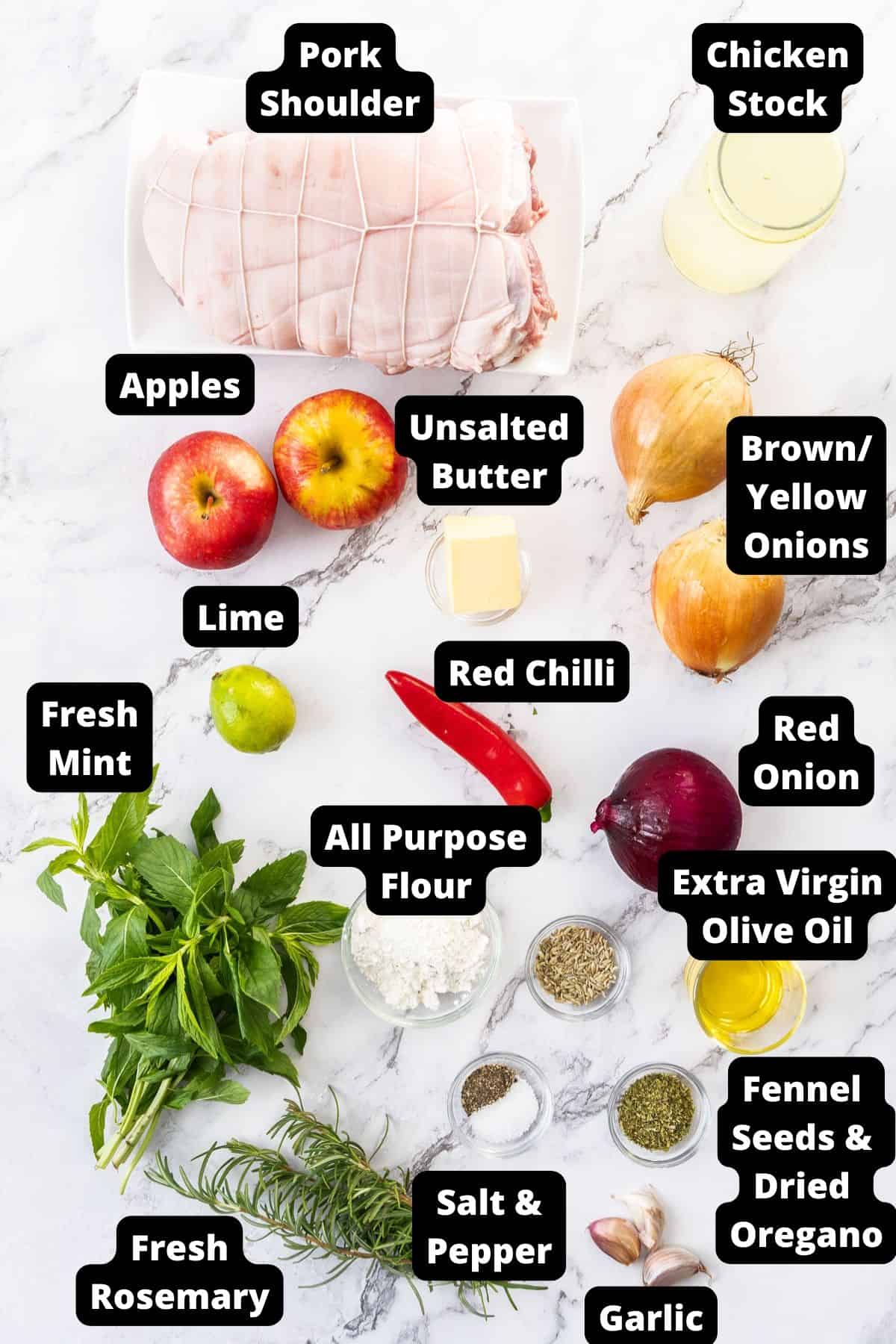
- Pork shoulder – we use a boneless, skinless pork shoulder. Pork shoulder is sometimes confused with pork butt, which, despite its name, is also from the shoulder and is higher up the shoulder. Both benefit from long, slow cooking methods and can be used interchangeably. Pork shoulders are slightly less fatty than pork butt.
- Cooking salt – to season the pork our preference is coarse sea salt.
- Black pepper – for the best flavour, use freshly ground black pepper. Pre-ground black pepper lacks freshness and tends to taste dull.
- Garlic cloves – slivers of fresh garlic are inserted into the meat, adding great flavour.
- Fresh rosemary – for extra flavour in the pork, we insert fresh rosemary leaves along with the garlic into the pork flesh as well as adding some chopped rosemary to the pan in which it cooks.
- Extra virgin olive oil – the oil is added to the pan to brown the pork.
- Dried oregano – in this instance, our preference is for the dried herb. The fresh herb is considerably more pungent, and the flavour may dominate.
- Fennel seeds – have a mild anise flavour and are a popular spice in Italy to use with pork. They go so well together.
- Brown/yellow onions – this is the onion most often used in cooking. You can use white onions if you prefer.
- Chicken stock – use homemade stock or a good quality commercial variety. We pour chicken stock around the pork to add flavour and keep the meat juicy and tender.
- Unsalted butter and plain/all-purpose flour – using these ingredients, we make a roux for the gravy.
- Apples – use a crisp apple that you enjoy eating. We used Pink Lady with the skin on to add colour to the salsa.
- Red onion – this onion is sweeter than the brown/yellow onion, making it ideal for eating raw in salads.
- Mint leaves – this is one of my favourite herbs. Fresh mint leaves are sweet, refreshing and fragrant. It is a versatile herb that can be used in sweet or savoury dishes or drinks. I use it in many dishes, such as my Avocado, Yoghurt and Mint Dip or my Grilled Lamb Cutlets with Mint Pesto.
- Lime juice – freshly squeezed lime juice adds necessary acidity and enhances the flavours of the other ingredients.
- Sea salt flakes – good quality salt is a great flavour booster.
- Red chilli – we use a cayenne chilli to add spice and colour – add according to your taste or omit if you prefer.
Variations:
Herbs – you can vary the herbs to go with the pork according to your preference. Fresh thyme, marjoram or sage are all good options. If substituting fresh herbs for dried, you will need to use 3 times the amount.
Stock – you could use vegetable stock if you prefer.
Vegetables – if you wish, you could add some carrots for extra flavour, but with the long, slow cook, they will almost melt into the dish. Therefore, I recommend you add them when you check the pork after 2 hours cooking.

How To Make Slow Roasted Pork Shoulder:
Please see the recipe card further along in the post for exact quantities of ingredients and the full method.
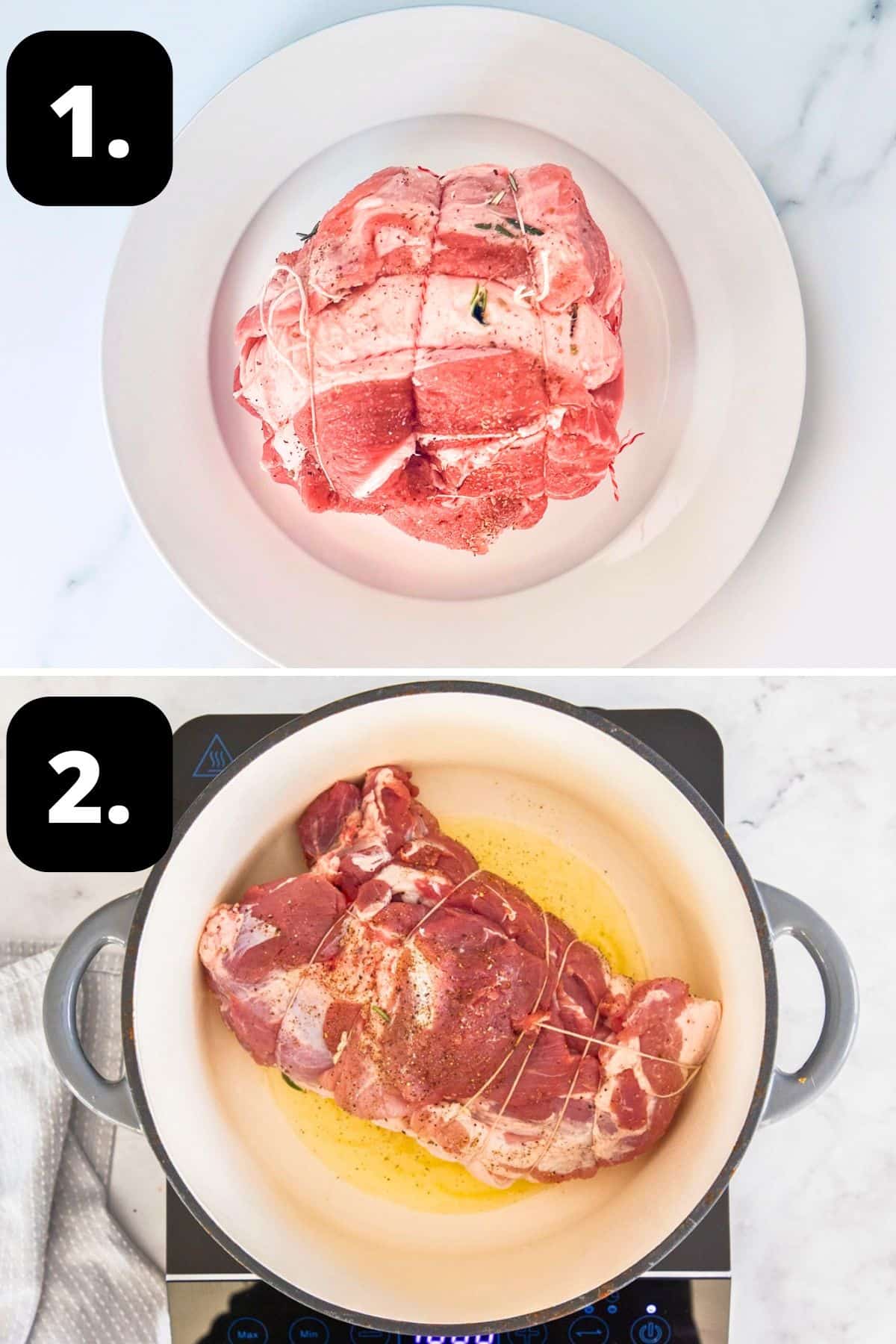
1 – Season the pork:
Truss with string if not already done by the butcher.
Make deep inserts into the skin/fat side of the pork flesh and insert a garlic sliver and rosemary leaves into the flesh. Repeat this process on both sides.
Combine the salt and black pepper, rub into the shoulder and set aside at room temperature for 10 minutes.
2 – Sear the pork:
In a large, heavy-based Dutch Oven or oven-safe saucepan with a tight-fitting lid, heat the olive oil on medium-high heat. Add the pork, fat side down, and brown both sides.
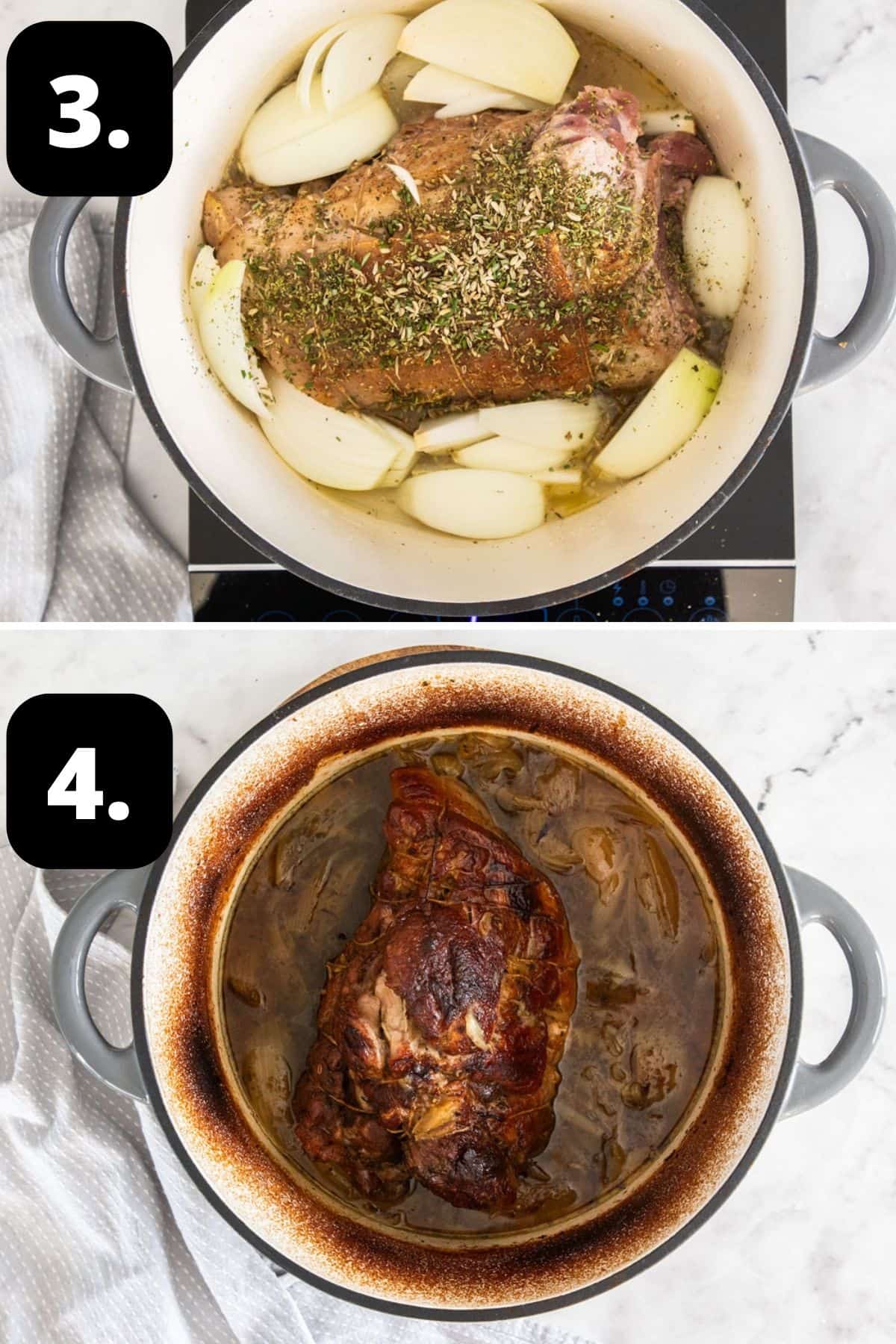
3 – Add in the seasonings:
Turn off the heat and add the onion wedges. Sprinkle the pork with dried oregano, chopped rosemary and fennel seeds and pour the chicken stock around the meat. Put the lid on the saucepan and place it in the preheated oven.
4 – Slow Roast:
After about 2 hours, carefully remove the pan from the oven, baste the pork with the juices and return to the oven for another 2 ½ hours. Remove from the oven and stand for 10 minutes before pulling the pork apart and serving with the salsa.
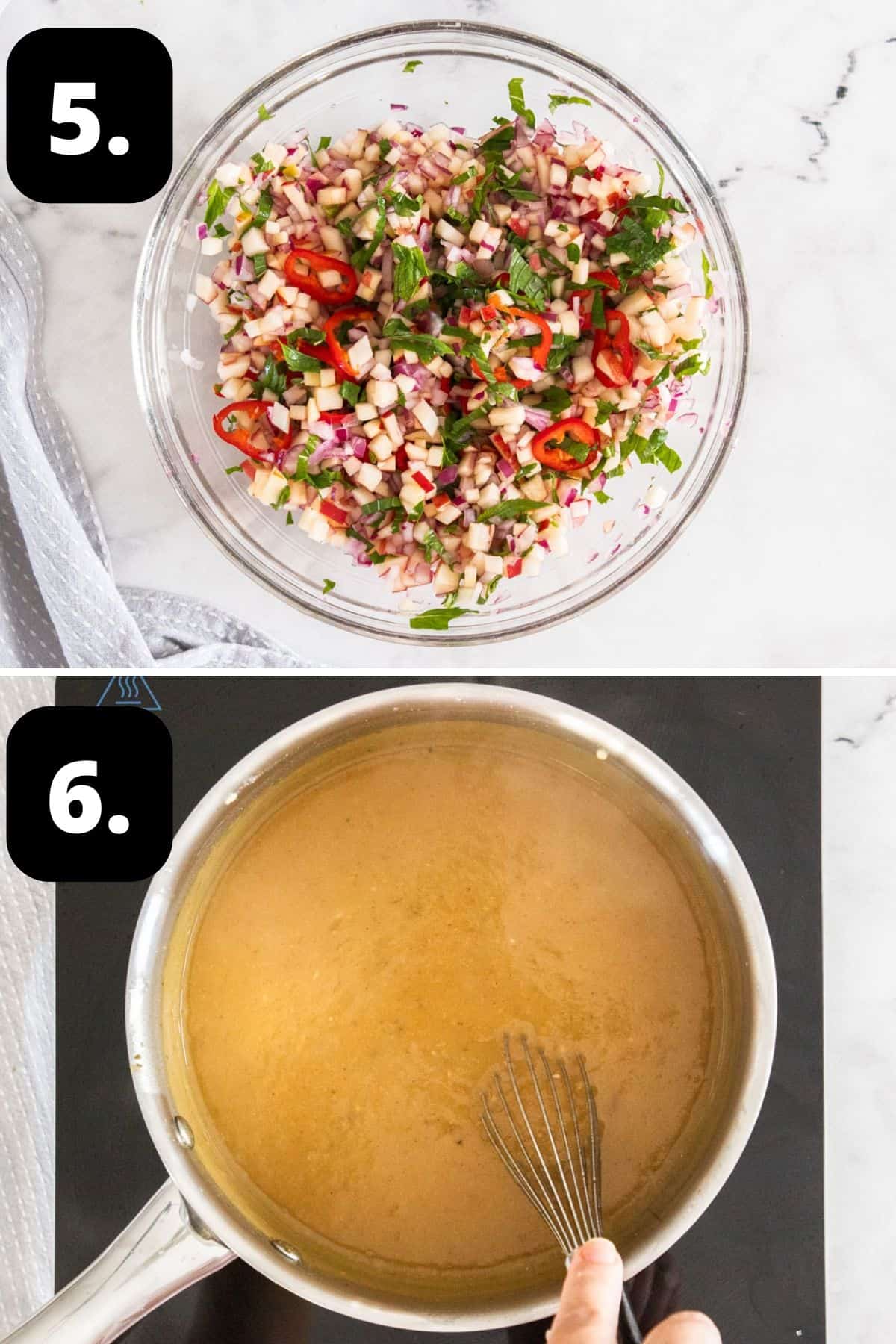
5 – Prepare the Apple Salsa:
When you are close to serving, make the Apple Salsa. Combine all of your finely chopped ingredients in a medium size bowl. Season to your liking.
6 – Prepare the Gravy:
To make the Homemade Gravy, melt the butter and add the flour. Stir in the pan juices and cook until thickened.
Hint: the pork will be very tender so you will need to remove it carefully or it may fall apart.

Tips for Success, Storage and FAQs:
It is not essential, but it is preferred. Browning the meat gives the dish a more appetising appearance and the caramelisation adds tremendous flavour. It does not take much time, so I strongly recommend that you do it.
This is an important tip; always let your meat rest before serving. A well-rested piece of meat will be more tender and succulent. Once cooked, move the pork to a platter and set it aside to rest for 10-15 minutes. This will enable the juices to redistribute throughout the meat.
It is important to check halfway through cooking to make sure that there is enough liquid and baste the meat as it helps retain moisture and prevent the meat from becoming dry.
Cool leftovers as quickly as possible and store in the fridge in an airtight container for up to 3 days. However, for safety reasons, if the pork has been at room temperature for 2 hours, it should be discarded.
Yes, it freezes very well. Like my Slow Roasted Lamb Shoulder, you can freeze leftovers in a freezer-safe container for up to 2 months. Make sure the pork has cooled then separate it into portions before wrapping in cling wrap and storing in a freezer safe container or ziplock bag. Gently reheat it using some liquid to keep the flesh moist. Use chicken stock or water in the microwave, oven or frying pan. It should be heated to register 75 degrees C (165 F) throughout.
Top Tip:
For the best result, bring the pork to room temperature before cooking. This ensures that the meat cooks more evenly.
As always, you will get the best result with good quality produce.

Serving Suggestions:
Slow Roasted Pork Shoulder is extremely versatile. Some ways to enjoy it are:
- As a traditional roast accompanied by Crispy Roasted Smashed Potatoes and Roasted Red Pepper Salad.
- With a carb such as Baked Mashed Potatoes, creamy polenta, rice or pasta to soak up the flavoursome juices.
- Shredded, to serve in a sandwich or burger bun with our Spicy Cucumber Pickles.
- Set up a buffet with shredded pork, bread, condiments and side dishes for guests to help themselves. It is a stress-free way to entertain.
- Make a sandwich with the pork and our Plum Chutney.
This very easy Slow Roasted Pork Shoulder is a guaranteed crowd-pleaser. This simple one-pot oven dish is a meal that is both satisfying and comforting. As the pork roasts, the aroma is warm and inviting, enticing everyone with the pleasure of the meal to come. A vibrant, tangy, apple salsa is the perfect accompaniment to the full flavoured pork.
Alex xx
More Delicious Recipes For You To Try:
Stay in touch!
Follow me on Facebook, Pinterest, Flipboard and Instagram and subscribe to my newsletter.

Slow Roasted Pork Shoulder
Please note:
For accuracy, when weights are provided, we recommend weighing your ingredients. This will produce the best results. All oven temperatures listed are for fan forced.
Ingredients
For the Slow Roasted Pork Shoulder:
- 1.5 kg (3.3 lb) boneless pork shoulder – without the skin See Note 1
- 1 teaspoon coarse cooking sea salt
- ½ teaspoon freshly ground black pepper
- 3 large garlic cloves – cut into slivers
- 1 large fresh rosemary stalk – more if necessary See Note 2
- 2 tablespoon extra-virgin olive oil See Note 3
- 2 large brown/yellow onions – each peeled and cut into 8 wedges with some root attached See Note 4
- 2 teaspoon dried oregano
- 1 ½ teaspoon fennel seeds
- 1 teaspoon fresh rosemary – finely chopped
- 2 cups (500 ml) chicken stock – homemade or store bought See Note 5
For the Apple Salsa:
- 2 large apples – finely diced – use apples you enjoy eating. I used Pink Lady.
- ½ medium red onion – finely chopped
- ¼ cup fresh mint leaves – finely chopped and firmly packed
- 5 teaspoon fresh lime juice – or to taste
- ¼ teaspoon sea salt flakes – or to taste
- long red chilli – thinly sliced – optional
For the Gravy:
- 2 tablespoon (40 g) unsalted butter
- ¼ cup (40 g) plain/all-purpose flour – can use gluten-free
- 2 cups (500 ml) stock from the cooked pork
Instructions
For the Slow Roasted Pork Shoulder:
- Remove the pork shoulder from the fridge. Our pork shoulder came without the skin, which is ideal for making shredded/pulled pork. If yours comes with the skin, you will need to remove it. If you wish, you could use it to make crackling. Truss with string if not already done by the butcher. This helps it keep a nice shape. (See Note 1)
- Preheat your oven to 140 degrees C (285 C).If the pork shoulder has a lot of moisture, pat it dry with paper towel.Using a sharp knife, make a deep insert into the fat side of the flesh and insert a large garlic sliver and about 5 rosemary leaves into the flesh. Use the tip of a blunt knife to push them down.
- Repeat this procedure, around the entire pork shoulder, leaving a space of about 2.5 cm (1 inch) between.Combine the salt and black pepper and rub into the shoulder. Set aside at room temperature for 10 minutes.
- In a large, heavy-based Dutch Oven or oven-safe saucepan with a tight-fitting lid, heat the olive oil on medium-high heat. Add the pork, fat side down, and brown for 3–5 minutes. Turn it over and brown the other side for 3–5 minutes.
- Turn off the heat on your stove top and add the onion wedges around the pork. Sprinkle the pork with the dried oregano, fennel seeds and chopped rosemary and pour the chicken stock around the meat.Put the lid on the saucepan and place in the preheated oven.
- After about 2 hours, carefully remove from the oven and check that there is sufficient liquid – there should be plenty. If there isn't, add a little more stock.Baste the pork with the juices and return to the oven for another 2 ½ hours.
- Remove from the oven and stand for 10 minutes. The pork will be very fragile, so carefully remove it if you're wanting to serve it whole. Or, remove to a board and shred the meat with two forks.Serve the pork with the delicious Gravy and Apple Salsa.
For the Apple Salsa:
- Add all the ingredients to a medium size bowl and toss together gently. Check that the seasoning is to your liking, adding extra lime juice or salt to suit your taste. If using chilli, sprinkle some over the top of the salsa and serve the remainder separately.
For the Gravy:
- To a small saucepan, add the butter and melt over medium heat. Add the flour, and using a whisk, mix it into the butter. Cook for 1–2 minutes.Add in the pan juices, along with some onions if you wish. Bring to a simmer and allow to thicken slightly. Add more stock if necessary to get the consistency you like.Use an immersion blender to carefully blend the gravy to a smooth consistency.
Notes
- Pork shoulder: to begin, we need to truss the pork and we do this for two reasons; to help the meat have a more uniform shape and therefore cook more evenly. You may find the butcher has already trussed the meat or is happy to do it for you. But if not, it’s not difficult. There are classic techniques used by butchers. They use a continuous length of twine, using specific knots, but you can get a good result with a simpler method. To begin, you will need kitchen twine. Shape the pork shoulder with your hands and bring a loop of twine around, tie it as tightly as you can and cut off the ends. Repeat at 2.5 cm/1 inch intervals. It will still give you a good result.
- Rosemary: we use sprigs of rosemary to insert into the pork with slivers of garlic. We also add some finely chopped rosemary to the roasting pan.
- Tablespoon: we use a standard Australian tablespoon which is 20 ml (4 teaspoons). For readers located elsewhere in the world, please use 1 tablespoon + 1 teaspoon for each listed tablespoon.
- Brown/yellow onions: leave some root attached so the wedges stay intact.
- Chicken stock: a full-flavoured stock is preferable as it adds good flavour to the pork. It is unlikely you will need to add more liquid, but if you find it drying out when you check after 2 hours cooking, add a little more stock to the pan. We recommend using either chicken or vegetable stock.
- Seasoning: adjust the seasoning to your liking – we recommend using freshly ground black pepper and sea salt flakes for the best flavour.
- Storage: cool leftovers as quickly as possible and store in the fridge in an airtight container for up to 3 days. However, for safety reasons, if the pork has been at room temperature for 2 hours, it should be discarded.
- Freezing: freeze leftovers in a freezer-safe container for up to 2 months. Cool the pork, separate it into portions, wrap in cling wrap and store in a freezer safe container or ziplock bag.
- Reheating: gently reheat using some liquid to keep the flesh moist. Use chicken stock or water in the microwave, oven or frying pan. It should be heated to register 75 degrees C (165 F) throughout.
- Servings: will serve 4-6 people, depending on what it is served with.
Nutrition Estimate:
Nutritional Disclaimer:
The nutritional information is an estimate only, and is derived from online calculators. For accurate results, we recommend calculating the nutritional information based on the ingredients and brands you use.















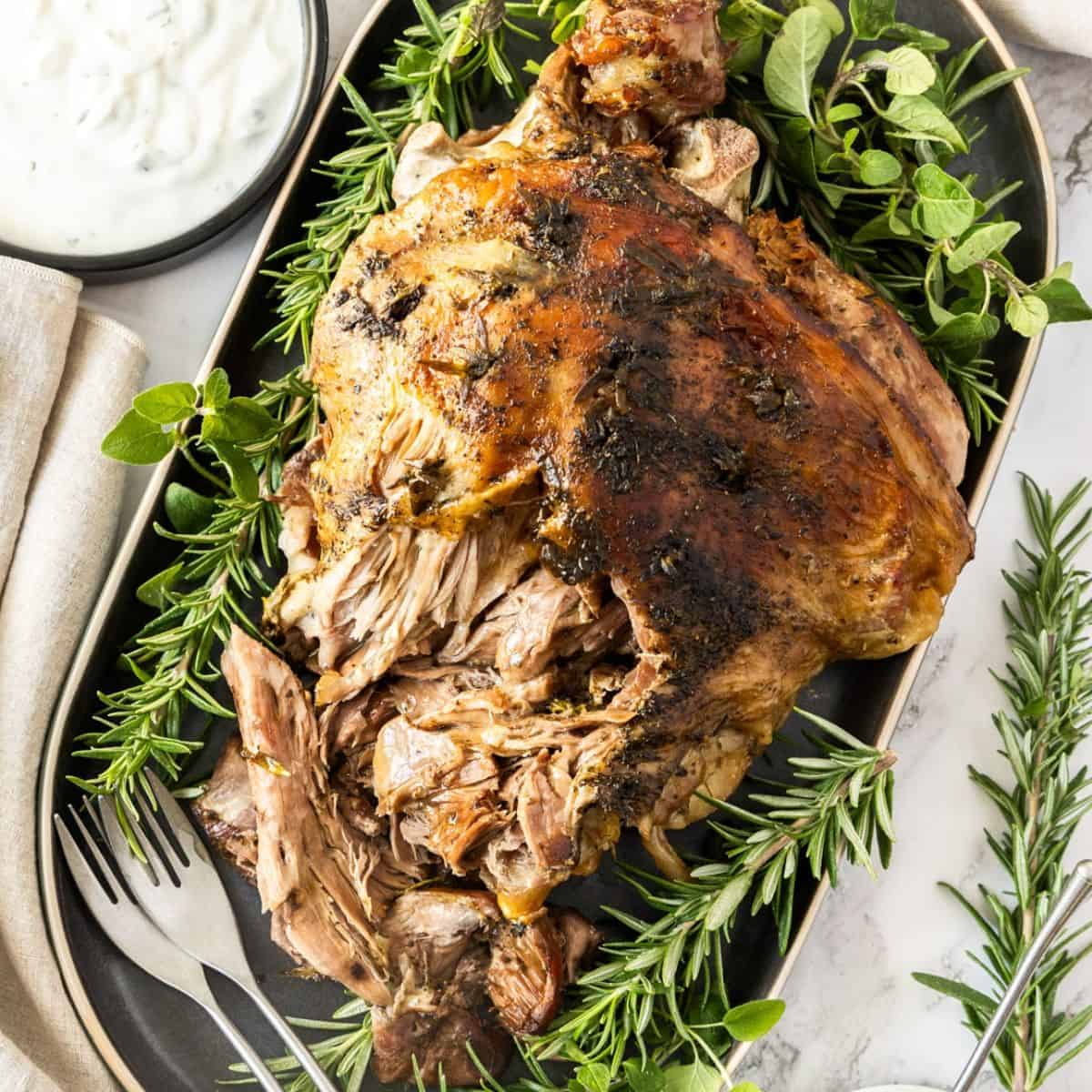
Leave a Comment